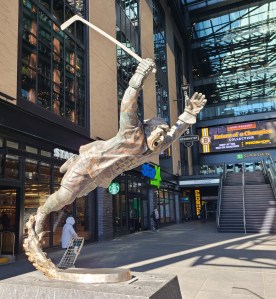
A statue of Boston Bruins great Bobby Orr stands beside TD Garden in Boston. An entrance to North Station can be seen between the stairs the arena. Steve Collins/Sun Journal
It takes half an hour, much of it along the Rose Kennedy Greenway that marks the site of the Big Dig that buried an unsightly highway two decades ago and restored Boston’s urban center.
That little one-and-a-half-mile amble through history is also at the center of an unfortunate mistake of the past: the failure to link the two stations so a train arriving at one of them can continue to the other.
What that means is that those who board a commuter rail car north of Boston or an Amtrak Downeaster in Maine must get off at North Station, if they go as far as they can.
And those who board a train of any sort south of Boston, whether it’s in Plymouth or Philadelphia, must exit at South Station.
It’s impossible to go directly between, say, Portland and New York City, though travelers can take the subway, with a transfer along the way, or call an Uber or simply schlep their way along the sidewalks between stations.
But so far, nothing has changed.
Yet there are serious stirrings in Boston and beyond, indicating the time to tie the northern and southern routes into a single system may be at hand.
The proposed underground Rail Link calls for digging a 130-foot-deep, 2.9-mile tunnel between the two stations and knot them together with commuter and Amtrak lines and Boston’s Back Bay Station.
It would cost $8 billion or more, but experts say the economic benefits far outweigh the expense.
The nonprofit TransitMatters said adding the missing link would allow “service between any two stations” in the region “with either a direct trip or a single, seamless transfer,” creating “the flexibility and connectivity to which many riders and potential riders would be drawn.”
One of the project’s chief promoters, U.S. Rep. Seth Moulton, a Massachusetts Democrat, said that “until we build the Rail Link, we won’t just be stuck in traffic, we’ll be stuck in the past.”
Moulton said, “The question is no longer ‘Can we afford to build the link?’ but ‘Can we afford not to?’”
HISTORY OF THE RAIL GAP
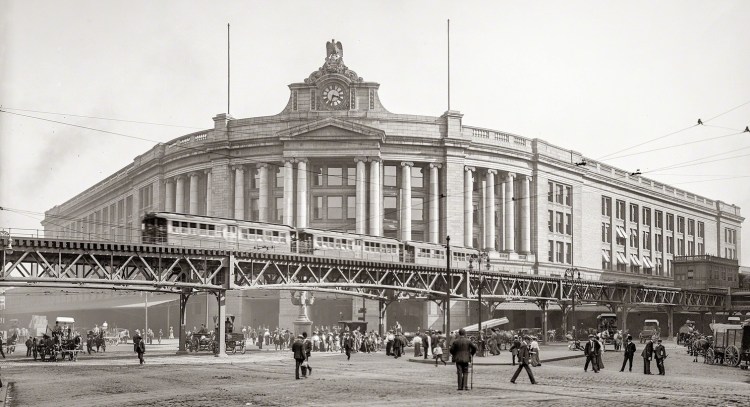
South Station in Boston about 1920 with the Atlantic Avenue Elevated line running in front of it that once linked North and South stations in Boston. A new proposal would create an underground rail link. Boston Public Library
It’s difficult to overstate just how railroad-crazy America once was. Lines crisscrossed even remote regions, including areas of Maine where almost nobody lived.
There were tiny stations hither and yon, sprawling rail yards and all sorts of inefficient ties between competing lines that made getting around confusing and costly.
In Boston, moneyed leaders in the industry figured out how to consolidate the lines running into Boston from Worcester and all the others around the city to the north so they ran into a huge new station constructed in 1893 and named, with a rare simplicity, North Station
It quickly became the busiest railroad station in America.
Seven years later, in 1900, South Station opened a bit more than a mile away, capturing the many other lines coming into Boston.
It didn’t take long for municipal and state officials in Massachusetts to recognize there ought to be tracks between the two terminals so people could travel from either direction without having to disembark to get past the North or South station.
John Martin, president of the Massachusetts Real Exchange, said in 1912 that a tunnel between the stations would provide “the easiest and cheapest means of transporting passengers and goods from the north to the south side of the city.”
At the time, though, advocates couldn’t overcome opposition from the New Haven Railroad Co., which owned a controlling stake in the Boston & Maine Railroad. It wanted to maximize profits on both sides of the city and saw no advantage to creating a link.
In any case, at the time there was a better option for switching between terminals than there is today.
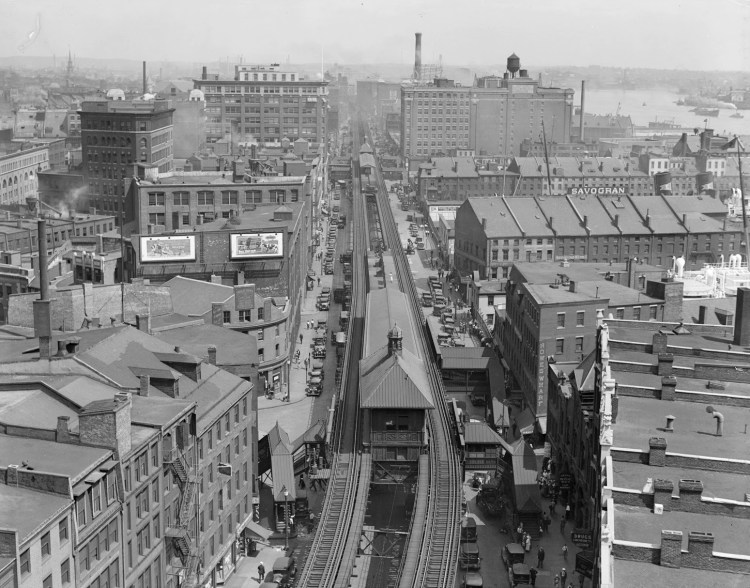
A 1932 photograph showing the Atlantic Avenue Elevated railway that ran aboveground between North and South stations until officials pulled it down for scrap metal during World War II. Boston Public Library
Beginning in 1896, the Atlantic Avenue Elevated line ran between both stations, delivering passengers directly from one to the other. Its presence relieved the pressure for a simpler, lasting option.
During the Great Depression, following years of ridership declines due to the shift to cars and buses, the elevated line ceased operations. Its slumbering ruins were cut down for scrap metal during World War II.
After that, it remained possible, as it is today, to take the subway from one train station to the next via a transfer at the Downtown Crossing stop. Doing so, however, requires passengers to hoof it for a fair distance, which isn’t always possible with luggage.
The bottom line, which became ever more obvious as time passed, was that the rail gap between North and South stations hindered the efficient operation of passenger trains and hindered hopes of expanding service.
PICKING UP THE STEAM AGAIN
During the 1980s, a major push for the long-postponed project got underway, with U.S. Sen. George Mitchell, a Maine Democrat among its top proponents.
Though the connection between the two stations never got approval — President Ronald Reagan thought it was too costly — the effort ultimately led to the creation of the Amtrak Downeaster that restored passenger rail service to Maine for the first time since 1965.
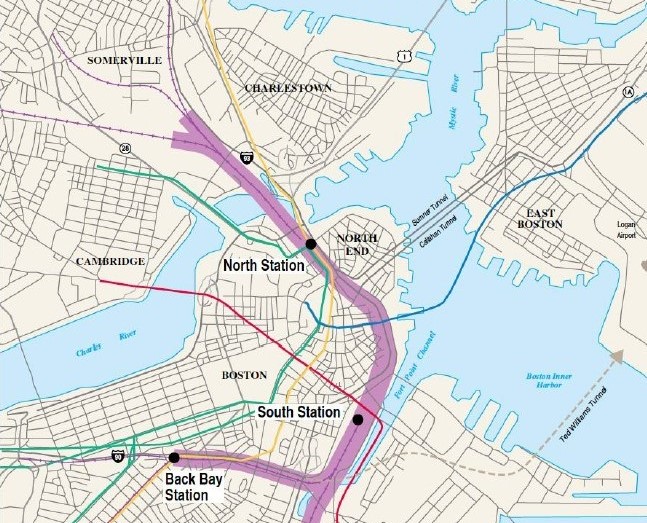
A map shows the proposed Rail Link project that would tie North and South stations together. Harvard Kennedy School Study, June 2024
But officials in Massachusetts kept the idea of a new rail link alive. It has long had the backing of former Govs. Michael Dukakis and William Weld, along with a few federal lawmakers.
A 2017 Harvard Kennedy School study, though, put some juice behind the project again.
The Massachusetts Department of Transportation determined in 2019 that the divided system “creates inefficient terminals” that limit the number of trains that “can enter and exit downtown during peak periods”
In addition, the DOT study pointed out that both stations “are stub-end terminals requiring trains to reverse direction to continue,” occupying tracks as they do so, which means schedules “must allow adequate time for turning around and checking equipment.”
An updated version of the Harvard study, completed a few months ago, estimates that the $8 billion project would produce $27 billion in economic benefits by adding at least 86 million additional train rides annually and spur the creation of 150,000 new housing units.
It would reduce carbon emissions, bolster the economy of communities touched by the rail lines and reduce traffic congestion in the Boston area, the study determined.
“The North-South Rail Link is an investment that will repay huge dividends” for Massachusetts and the rest of New England, said Linda Bilmes, the Daniel Patrick Moynihan Chair in Public Policy and Public Finance at the Harvard Kennedy School.
“Connecting North and South stations will eliminate a transportation bottleneck that has caused congestion for decades, and make it possible for the rail system to expand economic opportunities. It’s a real win-win for everyone,” she said.
Moulton said the project “would mean traveling around the state faster than driving, doubling or tripling access to housing and jobs, and connecting people from Maine to Miami.”
But for a century, he said, bureaucrats and politicians have “given the same tired excuses” about the endeavor being too costly or too difficult.
A CHOICE IS COMING
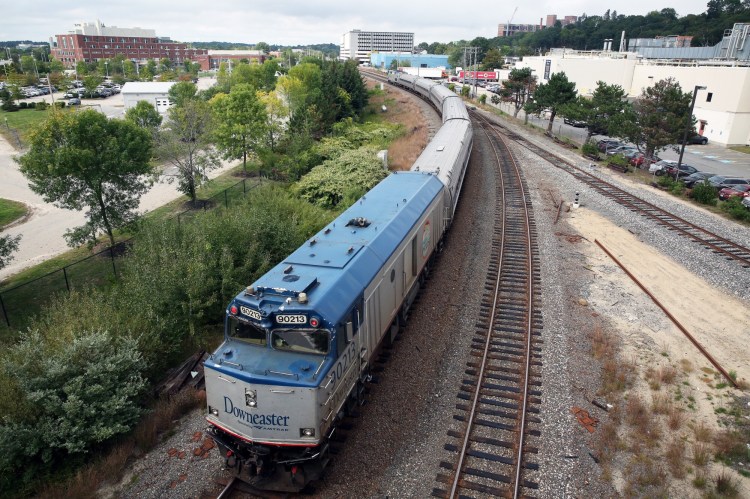
The Amtrak Downeaster arrives in Portland in 2022. The regional railway reported record-setting ridership in fiscal year 2024. Ben McCanna/Portland Press Herald file
Now, though, Boston has a choice to make” as officials ponder whether to spend $4 billion to upgrade a swamped South Station to handle growing crowds or “build the Rail Link” and accomplish much more.
Maine officials so far have had little to say about the idea, but they’re watching.
“While a rail link between North and South Stations in Boston would certainly be convenient, it would cost billions of dollars,” said U.S. Sen. Susan Collins, a Maine Republican who holds a top position on the powerful Appropriations Committee that helps decide where federal money should be spent.
“Ultimately,” Collins said, “the initial decision on whether or not to proceed would be made by the officeholders of Massachusetts.”
Collins added that she remains “a strong supporter of Maine’s Downeaster service” that runs between Brunswick and Boston’s North Station.
What will happen next with the Rail Link proposal is uncertain, but the long-delayed project may have its best chance ever of securing approval.
